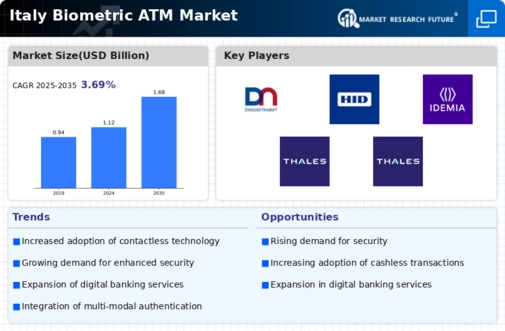Increased Investment in Financial Technology
Increased investment in financial technology is a driving force behind the growth of the biometric atm market in Italy. As banks and financial institutions allocate more resources towards innovative technologies, the integration of biometric solutions is becoming a strategic priority. In 2025, it is expected that investments in fintech will rise by 25%, with a significant portion directed towards biometric systems. This influx of capital is facilitating research and development, leading to the creation of more advanced biometric atms that offer enhanced security and user experience. Moreover, partnerships between technology providers and financial institutions are becoming more common, further propelling the biometric atm market forward. This trend suggests a robust future for biometric solutions as they become integral to the evolving landscape of financial services.
Rising Demand for Enhanced Security Solutions
The biometric atm market in Italy is experiencing a notable surge in demand for enhanced security solutions. As financial institutions and consumers alike prioritize security, the adoption of biometric technology is becoming increasingly prevalent. In 2025, it is estimated that the market will grow by approximately 15% annually, driven by the need to combat fraud and identity theft. Biometric systems, such as fingerprint and facial recognition, offer a higher level of security compared to traditional PIN-based systems. This shift towards biometric solutions is not only a response to consumer concerns but also a proactive measure by banks to safeguard their assets and maintain customer trust. Consequently, the biometric atm market is poised for significant growth as institutions invest in advanced technologies to meet these rising security demands.
Technological Advancements in Biometric Systems
Technological advancements are playing a crucial role in shaping the biometric atm market in Italy. Innovations in biometric recognition technologies, such as improved algorithms and sensor capabilities, are enhancing the accuracy and efficiency of these systems. For instance, the integration of artificial intelligence and machine learning is enabling more sophisticated biometric verification processes. As of 2025, the market is projected to expand by 20% due to these advancements, which are making biometric atms more user-friendly and reliable. Furthermore, the decreasing costs of biometric hardware and software are facilitating wider adoption among financial institutions. This trend indicates a shift towards more automated and secure banking experiences, positioning the biometric atm market as a key player in the future of financial transactions.
Consumer Demand for Convenient Banking Solutions
Consumer demand for convenient banking solutions is significantly influencing the biometric atm market in Italy. As customers increasingly seek seamless and efficient banking experiences, biometric atms are emerging as a preferred option. The ability to access funds without the need for physical cards or memorized PINs appeals to a tech-savvy population. In 2025, it is projected that the market will grow by 12% as more consumers embrace biometric authentication methods. This shift is indicative of a broader trend towards digitalization in banking, where convenience and speed are paramount. Financial institutions are responding to this demand by investing in biometric technologies, thereby enhancing customer satisfaction and loyalty. The biometric atm market is thus positioned to thrive in an environment where consumer preferences are rapidly evolving.
Regulatory Framework Supporting Biometric Implementation
The regulatory framework in Italy is increasingly supportive of the biometric atm market, fostering an environment conducive to the adoption of biometric technologies. Government initiatives aimed at enhancing security measures in financial transactions are encouraging banks to implement biometric solutions. In 2025, it is anticipated that compliance with new regulations will drive a 10% increase in the deployment of biometric atms across the country. These regulations not only promote the use of biometric identification but also establish standards for data protection and privacy, addressing consumer concerns. As financial institutions align with these regulatory requirements, the biometric atm market is likely to see accelerated growth, as banks seek to enhance their service offerings while ensuring compliance with legal standards.
















Leave a Comment